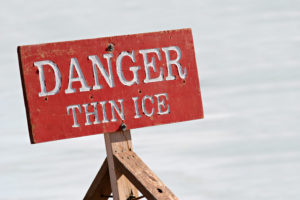** Purported Class Action Attempts to Sink Starbucks with claims over allegedly misleadingly frozen water **
By: Brent E. Johnson

Last week, a disgruntled Starbucks patron in Chicago filed a putative class action against the coffee icon in the Northern District of Illinois claiming that consumers like her have been defrauded over the past ten years by big plastic cups of ice. Pincus v. Starbucks Corporation, 1:16-cv-04705 (N.D. Ill. April 27, 2016) (Dkt. No. 1). Granted, all of the drinks that are part of the lawsuit are called “Iced Something-Or-Other,” but according to the Plaintiff that doesn’t justify Starbucks putting ice in the beverages. Okay, that’s overstating it a bit.
The lawsuit hinges on Starbucks’ use of the acronym for fluid ounce (“fl. oz.”) on its menus and in other advertising. Plaintiff contends that “fl. oz.” means just that – an ounce of fluid – and the actual fluid ounces in Starbucks iced drinks are less than those claimed in its advertising. It is only by putting pre-measured scoops of ice in the drinks that the nefarious Starbucks baristas are able to completely fill those ubiquitous transparent cups. Starbucks, of course, is behind the whole scheme supplying the baristas with beverage cups with fill-lines printed on them (product/water or lemonade/ice) as well as different size ice scoopers (Tall/Grande/Venti). Plaintiff claims that she, and millions of other Starbucks aficionados across the United States, relied on the Company’s representations about the number of fluid ounces in their drinks and “Plaintiff would not have paid as much, if anything for the Cold Drinks had she known that it [sic] contained less, and in many cases, nearly half as many, fluid ounces than claimed by Starbucks.”
“Ounce” is Middle English from the Anglo-French “unce” and is a unit of mass equal to 1/16 of an avoirdupois pound and 1/12 of the troy pound favored by precious metal dealers. More importantly, an ounce is 0.666682 of a jigger of Jim Beam. Accordingly, any class certified in this case must certainly exclude gold investors and may need to be limited to hard core drinkers who know what an ounce looks (and feels) like. But while the public may have some difficulty visually identifying an ounce, they certainly know the difference between a Grande and a Venti, which is, after all, what they’re buying.
Plaintiff’s class definition is “[a]ll persons in the United States of America who purchased one or more of Defendant’s Cold Drinks at any time between April 27, 2006 and the present.” “Cold Drinks” include, but are not limited to, “iced coffee, shaken iced tea, shaken iced tea lemonade, Refreshers®, and Fizzio™ handcrafted sodas” (which, as an aside, are sadly not available at all Starbucks locations – but for those in the right locale, our pro tip is the Golden Ginger Ale). Although both cold and a drink, the Frappuccino® is not included. And that’s the whole problem with this case, isn’t it?
The Frappuccino® contains plenty of ice. But because the ice is blended with the flavored ingredients, it apparently qualifies as a liquid even though it’s really tiny shards of ice. Which raises the questions: If the ice melts in a Starbucks Iced Coffee before the purchaser finishes drinking it, is the purchaser getting the advertised number of fluid ounces? What if the purchaser is an ice chomper? Plaintiff’s complaint shrewdly anticipates these defenses. First, Starbucks uses “large pieces of ice” that “take up more space and thus when melted, will yield fewer measured ‘fluid’ ounces of coffee or tea . . . .” (Starbucks is skimping on the water!) More broadly, Plaintiff declares that “a reasonable consumer does not wait for the ice in a Cold Drink to melt before consuming the Cold Drink.” This point, of course, will require survey evidence to establish — or perhaps the class can be limited to purchasers of Starbucks Cold Beverages who are not sippers or chompers. (Ascertainability might be a problem here.)
Starbucks suffers from its transparency (which is the opposite of the problem it faced in a now dismissed slack fill case against it filed in New York). Anyone who purchases an iced beverage for the first time – particularly a shaken iced tea, a Refresher® or a Fizzio™ – is startled when the barista pours such a small amount of the flavored stuff in the bottom of one of those big plastic cups and then tops it off with water (or lemonade) and finally, a huge mound of ice. A Diet Coke from the McDonald’s drive-thru window retains its mystery. How much syrup? How much ice? But for those who love Starbucks, the beverages are consistently great – a treat to be savored slowly . . . while the triple-filtered ice melts.
